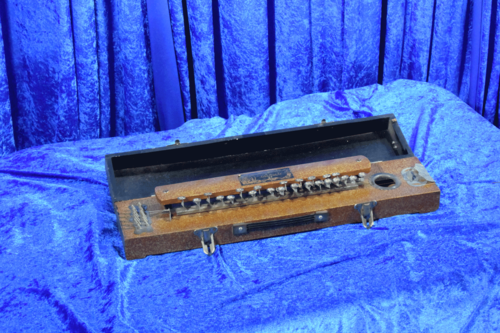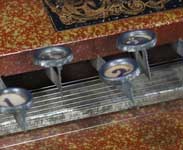(a.k.a. Banjo)


Bulbul tarang, also known as the “banjo”, is a common instrument in India. The name bulbul tarang literally translates to “waves of nightingales”. It is made of a number of strings passing over what resembles a finger board. However, instead of directly fingering the keys, they are pressed with a series of keys like a piano. Sometimes the keys are similar to a piano keyboard, but more often they resemble typewriter keys. The instrument is common for folk musicians and children because of its very low price.
The origin of the bulbul tarang is interesting. It is an Indian version of the Japanese taisho koto. The first taisho koto was built by Goro Morita in 1912 in Nogoya Japan. The term taisho refers to the second former Japanese emperor; while the term koto refers to it being a stringed instrument. The taisho koto became a very popular instrument in Japan; by 1929 it is estimated that over quarter of a million units were sold. Although it is established that the bulbul tarang is derived from the taisho koto, the obvious question is “what was the situation before that?” There is great reason to believe that the taisho koto is a technical extension of the various pianolins, pianettes, and hurdy gurdies, that were popular in the 19th century.

Playing the bulbul tarang (photo courtesy of Abe Thomas)
| THESE BOOKS MAY NOT BE FOR YOU |
|---|
A superficial exposure to music is acceptable to most people; but there is an elite for whom this is not enough. If you have attained certain social and intellectual level, Elementary North Indian Vocal (Vol 1-2) may be for you. This has compositions, theory, history, and other topics. All exercises and compositions have audio material which may be streamed over the internet for free. It is available in a variety of formats to accommodate every budget. Are you really ready to step up to the next level? Check your local Amazon. |
Tuning the Bulbul Tarang
Tuning the bulbul tarang is very easy, however we must not forget that there are innumerable variations in size, number of strings, gauge of strings, etc. Therefore, we will just go over the general principles and you can work out the details.
The first step is to familiarise yourself with the strings. There are two types of strings; there are the drone strings and the melody strings. The melody strings run directly under the key-plate and are fretted by the keys. The drone strings run beside the key plate and are not fretted. This is illustrated below.

Parts of the Bulbul Tarang
Tune the melody strings to anything that is convenient. The strings themselves will tell you what this should be. If they are too tight, you may break the strings. If they are too loose, they will sound dull. Through experimentation you will find what the useful range of your instrument is.
The gauge of the strings is chosen according to ones convenience. In India, most people would use the bulbul tarang to accompany their singing. Therefore, the strings are chosen such that the pitch of the instrument matches the key that one sings in.
You will probably wish to tune all the strings to the same note. In most cases the strings will be the same gauge, so this is a natural thing to do. If they are all the same, you can perform an interesting trick. Try tuning some of them to the same note, but others you can slightly detune, so they are a wee bit high or a wee bit low. The should not be too high or low, or the instrument will simply sound out of tune; however if you keep them within about 5 to 10 cents, everything will be just fine. This range of tunings will produce a very rich tone.
Next, you orient yourself to the keyboard. It is immediately apparent that the bulbul tarang’s keyboard is reminiscent of the harmonium keyboard. The arrangement (i.e., whole-step; whole step; half step; etc.) is the same, but the whole will probably be transposed up or down to some arbitrary key. Decide which key is going to be your tonic. In India it will usually be either the “C” position or the “B” position. When you have decided what your tonic is going to be, you then tune the drone strings to the first (Sa) or the fifth (Pa). Ideally you will wish to tune to both of them. (for more information on the Indian scales go to Swara)
Now it is quite likely that at some point in this process things are not quite working out. When instruments are sold in India, there is a randomness in the choice of strings. It is understood that the user will replace certain strings with either higher or lower gauges. Many times bronze or brass will be added, especially to the drone strings. This opens up a bass quality to the instrument. It is also possible to take some of the melody strings and change the gauge / material, to set them an octave apart. Do not feel afraid to experiment with different strings. This ability to customise the instrument is one of the strengths of the bulbul tarang.
Now your bulbul tarang is in tune. Play away to your heart’s content.
Photo Gallery
Bulbul Tarang (Click on image)

Right side of Bulbul Tarang

Left side of Bulbul Tarang

Clasp

Tuning pegs

Keys

Keys and embossed metal plate

Embossed metal plate
